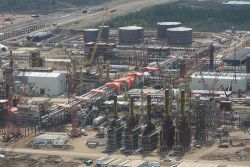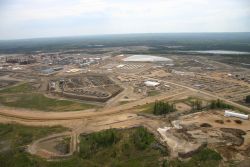We knew our first-ever report card on in situ oilsands impacts released Wednesday would garner some attention and hoped it would spark discussion about solutions to address the growing environmental impacts of deep oilsands production. Sure enough, the report gained media attention across North America and a flurry of responses from politicians.
Many in industry and government have been (inaccurately) painting in situ oilsands green. In situ projects get to bitumen that's too deep to mine, using drilling and steam injection, so there are no expansive tailings ponds created or open pit mines dug scarring the boreal landscape. In short, in situ oilsands projects aren't as photogenically disturbing as the open pit mines.

But as our findings revealed, some in situ oilsands operations' environmental performance is not only far worse than it could be, but on a number of counts, their level of environmental impact is even greater than that of oilsands mining operations.
Among nine in situ oilsands operations we evaluated, the average score was only 44 per cent. If industry were to follow its own best practices, that average score would be looking a lot better at 85 per cent. Clearly, there is some "low hanging fruit" to be had on the path to reducing impacts.
We came up with a number of recommendations in our report, including the need for government to step up and mandate improved environmental performance. This would guarantee consistent and better performance across all projects. Those best practices would increase efficiencies, improve environmental performance and perhaps even improve the industry's reputation by actually reducing impacts (and not just talking about it).
Unfortunately Alberta's new Energy Minister, Ron Liepert, didn't respond how we'd hoped. Mr. Liepert told reporters Wednesday, "we don't need more regulations" adding, "we have plenty of regulations in place to ensure that environmentally we are protecting Albertans." Instead of acknowledging the work we have to do to improve our environmental performance, he announced yesterday the Alberta government will beef up efforts to fight what he calls "propaganda campaigns" against the oilsands.
 Google map of in situ activity near Cold Lake, Alberta
Google map of in situ activity near Cold Lake, Alberta
"We are sometimes part of our own problem," he continued, "and we need to do a better part of selling what we have."
We believe it's time for Alberta to acknowledge we have an impact problem, not an image problem. That's the only path to regain public confidence.
Interestingly, Danielle Smith, leader of the Wildrose Alliance, has an entirely different take on the findings.
After reviewing the report, Smith released a statement and identified key findings she supported.
"With this report the Pembina Institute has brought forward some practical, reasonable and achievable goals that can help industry and our environment," she said. "This type of approach is an excellent example of industry and stakeholders working together to measure performance and continuously improve."
Perhaps Smith is tapping into what Preston Manning has been saying for a few years now: "There is no inherent reason why conservatives should be ambivalent on the environment, since conservation and conservatism come from the same root." Only time will tell, but previous polling we've conducted shows Albertans expect better environmental performance than we're seeing in the oilsands, and believe the government has a role to play in making sure it happens.

Most Canadians agree, oil sands are having a negative impact on the environment and our reputation as a country. Our in situ oilsands report reminds us all that industry has a way to go to clean up its act. Rejecting factual criticism of oilsands development will not solve our challenges in regaining public trust to develop energy resources responsibly in the province.
Simon Dyer is the deputy executive director of the Pembina Institute. He is based in Edmonton.



